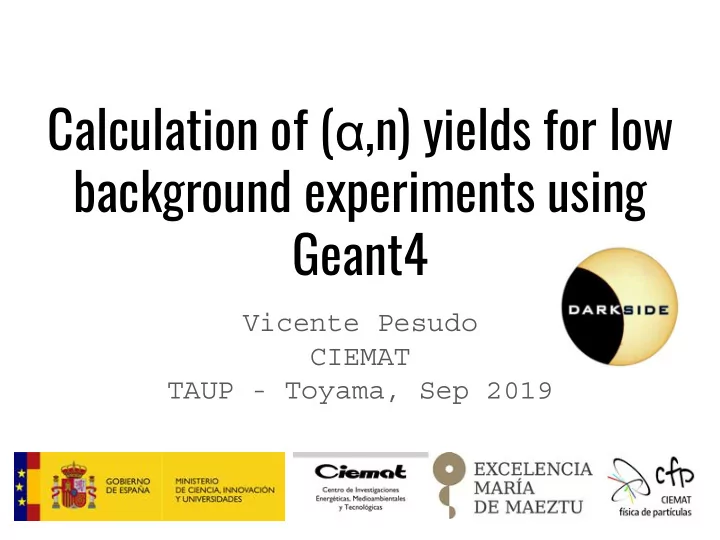

Calculation of ( α ,n) yields for low background experiments using Geant4 Vicente Pesudo CIEMAT TAUP - Toyama, Sep 2019
Authors - Combined effort of two groups at CIEMAT: Nuclear innovation: & Basic research: Emilio Mendoza Roberto Santorelli Daniel Cano Pablo García Abia Victor Alcayne Vicente Pesudo (the guy talking) Pablo Romojaro 2
OUTLINE ● context ● optimization (arxiv: 1906.03903) ● validation (arxiv: 1906.03903) ● application to DM-detector materials (DS-20k) 3
- Neutron recoils are irreducible background for WIMP searches. - In underground experiments, cosmogenic neutrons are heavily suppressed and easily tagged with active vetos. - The selection of radiopure materials is not enough to neglect the production of neutrons after an (α,n), where the α comes mainly from the U-238 and Th-232 decay chains. - Codes like TALYS (and hence TENDL) are useful for the overall picture, but differ from experimental values in some relevant cases. 4
Experience from materials working groups: - Lots of assays and a significant systematic uncertainty is accumulated in the neutron yield . It may cancel out in average, it may not. - Border effects very rarely taken into account (Kind of “cross talk”, but for α coming from one material and producing the neutron in the adjacent one). This may be especially relevant for: - surface contamination (Rn daughters plate-out, Rn diffusion…). - Small components with relatively high activity , high Z [low (α,n) XS], but adjacent to a material with high (α,n) XS. 5
- Geant4 is the simulation code more commonly used by particle physicists and in the low-E community. Versatile and detailed geometries. - For the (α,n) case: - Convenient for calculating the α tracks (EM processes). - Neutron production cross sections and energy distributions can be read from ENDF-6 format data libraries. Note: this involved some patching to Geant4.10.5 - It has particle and process biasing techniques: artificially enhance a particular XS to make the simulation more computationally efficient, (α,n) here. We wanted to go beyond the short term approach and provide the community with a versatile tool, easy to implement for any case. 6
Optimization of simulation parameters: Biasing of 10 2 - 10 4 optimal [case of 13 C(α,nX)Y @ 10 MeV] - Step Length of 10 -4 mm or below - 7
Example of performance for: step size 10 -4 mm. - bias factor 10 4 . - 8
We present a comparison between: - Different codes for (α,n) calculation. - JENDL2005 and several TENDL libraries for our code. Then, we present some applied case of interest for DM searches. Note that the JENDL libraries are not complete (only those XS measured experimentally), so a combined JENDL2005 + TENDL2017 library was implemented to study our cases of interest. 9
Comparison between codes, calculated/experimental: 10
Comparison between codes, calculated/experimental: 11
Cross sections for different TALYS evaluated libraries vs JENDL one using our code: TENDL, in this case: · Lack of resonances · Overall overestimation 12
Cross sections for different TALYS evaluated libraries vs JENDL one using our code: TENDL, in this case: · Lack of resonances · Overall overestimation 13
Cross sections for different TALYS evaluated libraries vs JENDL one using our code: TENDL, in this case: · Lack of resonances · Mild slope · Massive overestimation 14
Cross sections for different TALYS evaluated libraries vs JENDL one using our code: TENDL, in this case: · Lack of resonances · Small overestimation 15
Applications 8 MeV α in a Cu source surrounded by: more Cu: 7.5 e-8 n/ α vs LAr: 1.2 e-7 n/ α Increase of factor 1.6 16
Applications 8 MeV α Solder in LAr: 1.2 e-7 n/ α vs Solder on PCB in LAr: 8.8e-8 n/ α. Reduction in PCB side. Way of studying passive shields for ( α,n). 17
Applications 8 MeV α Solder in LAr: 1.2 e-7 n/ α vs Solder on PCB in LAr: 8.8e-8 n/ α. Reduction in low Z. Way of studying passive shields for ( α,n). 18
Applications 8 MeV α in a Cu cable: 7.4 e-8 n/ α vs with fluorine-based insulator: 4.5 e-7 n/ α factor 6.1 19
Conclusions: We are providing a new tool to estimate (α,n) yields, based on Geant4. We validated its performace in different isotopes and compared it with different codes. The improvement is two-fold: - Using experimental data where available. - Exploiting geometric, biasing and transportation capabilities of Geant4 . We expect an overall reduction in the uncertainty of the (α,n) yields. We proved that approaches like this one are fundamental for estimating properly the effects of: -surface contamination. -small dirty components with high-Z. 20
ANNOUNCEMENT: Workshop: “(α,n) background in dark matter experiments” 21-22 of November in Madrid If you are interested please contact any of us: Roberto Santorelli roberto.santorelli@ciemat.es Vicente Pesudo vicente.pesudo@ciemat.es 21
BACKUP 22
Copper disk lar 23
24
Recommend
More recommend